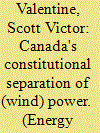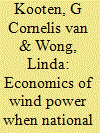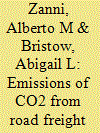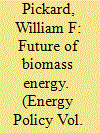|
|
|
Sort Order |
|
|
|
Items / Page
|
|
|
|
|
|
|
| Srl | Item |
| 1 |
ID:
094889


|
|
|
|
|
| Publication |
2010.
|
| Summary/Abstract |
This study offers Organization of Petroleum Exporting Countries (OPEC) member nations a crude oil pricing currency basket based on currency liquidity, in contrast with prior emphasis on OPEC trading patterns. Motivating the search for an alternative US dollar pricing of crude oil is the significant and inverse relationship (r=?0.82, p<0.01) between the US dollar major currencies index and crude oil price over the period January 1999-March 2009. A dynamically weighted petro-dollar currency basket is proposed based on the five currency claims (US dollar, Euro, British pound, Japanese yen and Swiss franc) and their varying proportions of foreign exchange reserves held by central banks. The major currencies US dollar index is compared against the proposed petro-dollar index to reveal an average US$8.1 billion annual gain in favor of the petro-dollar currency basket, offering OPEC members a revenue stream of diversified and highly liquid currencies to transition away from complete dependence on the US dollar crude oil pricing. The proposed petro-dollar crude oil pricing schema offers OPEC a crude oil price dynamically denominated in currencies reflecting the global use and importance of crude oil. This paper concludes with implementation issues facing a move toward the dynamically weighted petro-dollar crude oil pricing schema.
|
|
|
|
|
|
|
|
|
|
|
|
|
|
|
|
| 2 |
ID:
094859


|
|
|
|
|
| Publication |
2010.
|
| Summary/Abstract |
This study applies a threshold model proposed by to analyze the diffusion process of donating behavior for renewable energy. We first use a stated preference survey to estimate the determinants of a decision to support the donation scheme under various predicted participation rates. Using the estimated coefficients, we simulate how herd behavior spreads and the participation rate reaches the equilibrium. The participation rate at the equilibrium is estimated as 37.88% when the suggested donation is 500 yen, while it is 17.76% when the suggested amount is 1000 yen. The influence of environmentalism and altruism is also examined, and we find that these motivations increase the participation rate by 31.51% on average.
|
|
|
|
|
|
|
|
|
|
|
|
|
|
|
|
| 3 |
ID:
094910


|
|
|
|
|
| Publication |
2010.
|
| Summary/Abstract |
This study applies a socio-technical systems perspective to explore innovation dynamics of two emerging energy technologies with potential to reduce greenhouse gas emissions from electrical power generation in the United States: carbon capture and storage (CCS) and enhanced geothermal systems (EGS). The goal of the study is to inform sustainability science theory and energy policy deliberations by examining how social and political dynamics are shaping the struggle for resources by these two emerging, not-yet-widely commercializable socio-technical systems. This characterization of socio-technical dynamics of CCS and EGS innovation includes examining the perceived technical, environmental, and financial risks and benefits of each system, as well as the discourses and actor networks through which the competition for resources - particularly public resources - is being waged.
|
|
|
|
|
|
|
|
|
|
|
|
|
|
|
|
| 4 |
ID:
094878


|
|
|
|
|
| Publication |
2010.
|
| Summary/Abstract |
The production and consumption of electricity is a major source of CO2 emissions in Europe and elsewhere. In turn, the manufacturing sectors are significant end-users of electricity. In contrast to most papers in the literature, which focus on the supply-side, this study tackles the demand-side of electricity. An input-output approach combined with a sensitivity analysis has been developed to analyse the direct and indirect consumptions of electricity by eighteen manufacturing sectors in fifteen European countries, with indirect electricity demand related to the purchase of industrial products from other sectors which, in turn, require the consumption of electricity in their manufacturing processes. We identify the industrial transactions and sectors, which account for a greater share of electricity demand. In addition, the impact of an electricity price increase on the costs and prices of manufacturing products is simulated through a price model, allowing us to identify those sectors whose manufacturing costs are most sensitive to an increase in the electricity price.
|
|
|
|
|
|
|
|
|
|
|
|
|
|
|
|
| 5 |
ID:
094842


|
|
|
|
|
| Publication |
2010.
|
| Summary/Abstract |
In this work, we propose an index that allows a public authority to order different projects for the construction of onshore wind energy plants and that explicitly takes into account their environmental quality. Wind farm projects are defined as vectors of four attributes: the technical properties of each project, its social impact, its environmental impact, and the share of earnings that proponents offer to the collectivity in compensation for the negative externalities of the wind plant. We define an absolute index that allows the ordering of different proposals and evaluation of the acceptability of each project, providing the monetary value of each point and inducing a truthful revelation of firms' private information. Moreover, we calibrate the index on the basis of data referring to wind plants in Southern Italy and derive the corresponding iso-scoring curves.
|
|
|
|
|
|
|
|
|
|
|
|
|
|
|
|
| 6 |
ID:
094858


|
|
|
|
|
| Publication |
2010.
|
| Summary/Abstract |
The need to find cleaner, safer and less expensive sources of fuel in the city of Manaus, capital of the state of Amazonas (AM) in Brazil is inevitable due, among other factors, to the historical situation of the petroleum-derived fuel's large-scale use for power generation in the city by Brazil's energy planning. In this context, the use of natural gas in the province of Urucu, in the city of Coari countryside of the state of Amazons, is the best short-term solution, which will enable the substitution of petroleum-derived liquid fuels for the natural gas in the thermoelectric power plants in the city of Manaus and in seven other cities in the state, which are favored by the Coari-Manaus pipeline's main trajectory. This article presents the economic and environmental benefits with gas natural introduction in the energy matrix of isolated electrical system in Manaus. This project will be a great conquest for the city of Manaus, as a result of the Brazilian Energy Sector 20-year-planning, which will be completed in 2010, and will permit the beginning of a new growth-and-development cycle for the state of Amazonas and the Amazon itself.
|
|
|
|
|
|
|
|
|
|
|
|
|
|
|
|
| 7 |
ID:
094845


|
|
|
|
|
| Publication |
2010.
|
| Summary/Abstract |
Unilateral or sub-global policies to combat climate change are potentially sensitive to free-riding and carbon leakage. One way of dealing with carbon leakage and competitiveness is the imposition of border adjustment measures for competing imports, for example in the form of the obligation to importers of goods to purchase and surrender emissions allowances to the authorities when importing. In this paper, we explore some implications of border adjustment measures in the EU ETS, for sectors that might be subject to carbon leakage. We examine the implications of two variants of these measures on the competitiveness of these sectors and on the global environment with the help of a multi-sector, multi-region computable general equilibrium (CGE) model of the global economy. Our calculations suggest that border adjustment might reduce the sectoral rate of leakage of the iron and steel industry rather forcefully, but that the reduction would be less for the mineral products sector, including cement. The reduction of the overall or macro rate of leakage would be modest. So, from an environmental point of view border tax adjustments would not be a very effective policy measure, but might mainly be justified by considerations of sectoral competitiveness.
|
|
|
|
|
|
|
|
|
|
|
|
|
|
|
|
| 8 |
ID:
094880


|
|
|
|
|
| Publication |
2010.
|
| Summary/Abstract |
This paper investigates the impact that a federal government structure has on strategic selection of renewable energy policy instruments. The context for this study centers on wind power development in Canada. Canada is a nation that is blessed by all the attributes necessary to catalyze global leadership in installed wind power capacity. Unfortunately, the constitutional separation of powers that underpins Canada's federal system impedes the creation of a national wind power development strategy because Canada's provinces have constitutional authority over electricity governance. The insights gleaned from the case study are used to develop a conceptual framework for understanding the impact that federal structure has on policy instrument selection and efficacy under areas of federal, regional and concurrent policy jurisdiction. Finally, this framework is re-applied to identify specific approaches the Canadian federal government could take to resolve what currently amounts to be a fragmented, ineffective approach to wind power development planning.
|
|
|
|
|
|
|
|
|
|
|
|
|
|
|
|
| 9 |
ID:
094870


|
|
|
|
|
| Publication |
2010.
|
| Summary/Abstract |
The passing of the Renewable Energy Law (REL) in 2005 demonstrated China's commitment to renewable energy development. In the 3 years after the REL, China's renewable electricity capacity grew rapidly. From 2006 to 2008, China's wind capacity installation more than doubled every year for 3 years in a row. However, three facts prevent us from being optimistic about China's renewable electricity future. First, considered as a share of total capacity, renewable electricity capacity is decreasing instead of increasing. This is due simply to the rapid growth of fossil fuel capacity. Second, a significant amount of renewable generation capacity is wasted because it is not connected to the electricity grid. Finally, renewable electricity plants are running at a low level of efficiency. Based on an in-depth analysis of China's existing renewable energy policy, we suggest that these challenges should be dealt with by introducing a market-based mandatory renewable portfolio requirement coupled with strong regulatory monitoring of grid enterprises.
|
|
|
|
|
|
|
|
|
|
|
|
|
|
|
|
| 10 |
ID:
094911


|
|
|
|
|
| Publication |
2010.
|
| Summary/Abstract |
Local governments can have a large effect on carbon emissions through land use zoning, building codes, transport infrastructure investments, and support for transportation alternatives. This paper proposes a climate policy instrument - city carbon budgets - that provides a durable framework for local governments to reduce greenhouse gas emissions. Local governments would be assigned an emissions "budget", and would be required to keep annual local transport and buildings emissions within this budget. This policy framework could be implemented and managed by a higher-level government, or might be used in awarding funds to developing country cities from international climate funds. The state of California has enacted a version of this policy. In this paper, we identify and evaluate options for creating an effective and acceptable institutional structure, allocating emission targets to localities, measuring emissions, providing flexibility and incentives to local governments, and assuring compliance. We also discuss the likely costs of such a policy.
|
|
|
|
|
|
|
|
|
|
|
|
|
|
|
|
| 11 |
ID:
094917


|
|
|
| 12 |
ID:
094877


|
|
|
|
|
| Publication |
2010.
|
| Summary/Abstract |
The rural inhabitants of the Himalayan region have been exploiting forest resources for their livelihood for generations. The excessive and uncontrolled use of firewood for domestic purposes has ended up with severe deforestation. Therefore, quantification, assessment and restoration of such valuable but exhaustible resources and is imperative their scientific management. The estimates reflect that a total of 88 species are consumed as fuelwood (54 trees and 34 shrubs) by the local people. Fuelwood consumption by 'dhaba' (roadside refreshment establishments) owners (90-120 kg/household/day) was much higher over the common villagers (20-22 kg/household/day). The fuelwood is mainly burnt for cooking, water heating, space heating and lighting, etc. Among these, cooking consumes the fuelwood most. In addition, fuelwood demand increases due to influx of tourists. In the near future, this may also affect the status of the undisturbed forests at the middle elevation. The information in this communication could be utilized for developing various conservation and sustainable strategies in the region to mitigate the impact of forest resource for fodder and fuelwood.
|
|
|
|
|
|
|
|
|
|
|
|
|
|
|
|
| 13 |
ID:
094885


|
|
|
|
|
| Publication |
2010.
|
| Summary/Abstract |
During the last twenty years, the Spanish petrol market has undergone an intensive restructuration process; it has changed from being a state-owned monopoly to total liberalization and privatization. This liberalization process was accompanied by measures that facilitated the creation of a "national champion," the Repsol Group, which is a huge, vertically integrated company with a high market share in all the industry's segments. Using a dynamic model, this paper analyses whether the prices established by companies in the Spanish gasoline market, after the restructuration process, fits with a tacit collusion equilibrium. The empirical results show that a strategic behaviour of companies occurs and is compatible with a tacit collusion price strategy. So, the restructuration process does not seem to have introduced effective competition into the Spanish gasoline market.
|
|
|
|
|
|
|
|
|
|
|
|
|
|
|
|
| 14 |
ID:
094841


|
|
|
|
|
| Publication |
2010.
|
| Summary/Abstract |
In 2004, the reform of the Brazilian Electricity Market underwent a thorough revision. One of its causes was the electricity rationing that began in June 2001 and lasted until February 2002. Among other measures, the 2004 revision devised new mechanisms intended to reduce risks associated to contracts settled in electricity auctions and those related to investments in new generation plants. As 4 years have passed since the onset of the reform's revision, sufficiently enough data are now available for an analysis of the post-revision dynamics of the Brazilian Electricity Market. This is the purpose of the present paper. We focus on the dynamics of the different types of electricity auctions and on the so-called Mechanism for Compensation of Surpluses and Deficits, both created in the wake of the 2004 revision. The ultimate goal is to understand the behavior of the agents involved in auctions - notably buyers and sellers of electricity - and propose remedial actions to eliminate existing loopholes in the present regulatory framework. To achieve this goal, four steps were necessary. Firstly, a data base to support the analysis was built. Then, the main drivers of the dynamics of the risk management tools were identified. Finally, consequences of the implemented changes were discussed and corrections for observed pitfalls proposed.
|
|
|
|
|
|
|
|
|
|
|
|
|
|
|
|
| 15 |
ID:
094901


|
|
|
|
|
| Publication |
2010.
|
| Summary/Abstract |
Power interruptions are a typical characteristic of national grids in developing countries. Manufacturing, processing, refrigeration and other facilities that require a dependable supply of power, and might be considered a small grid within the larger national grid, employ diesel generators for backup. In this study, we develop a stochastic simulation model of a very small grid connected to an unreliable national grid to show that the introduction of wind-generated power can, despite its intermittency, reduce costs significantly. For a small grid with a peak load of 2.85 MW and diesel generating capacity of 3.75 MW provided by two diesel generators, the savings from using wind energy (based on wind data for Mekelle, Ethiopia) can amount to millions of dollars for a typical July month, or some 5.5-17.5% of total electricity costs. While wind power can lead to significant savings, the variability of wind prevents elimination of the smaller of two diesel units, although this peaking unit operates less frequently than in the absence of wind power.
|
|
|
|
|
|
|
|
|
|
|
|
|
|
|
|
| 16 |
ID:
094855


|
|
|
|
|
| Publication |
2010.
|
| Summary/Abstract |
Freight transport has been receiving increasing attention in both literature and practice following the growing recognition of its importance in urban transport planning. This paper analyses historical and projected road freight CO2 emissions in the city of London and explores the potential mitigation effect of a set of freight transport policies and logistics solutions. Findings indicate a range of policies with potential to reduce emissions in the period up to 2050. However, this reduction would appear to only be capable of partly counterbalancing the projected increase in freight traffic. More profound behavioural measures therefore appear to be necessary for London's CO2 emissions reduction targets to be met.
|
|
|
|
|
|
|
|
|
|
|
|
|
|
|
|
| 17 |
ID:
094834


|
|
|
|
|
| Publication |
2010.
|
| Summary/Abstract |
Why is it so difficult to change the energy policy status quo away from dependence on fossil fuels when the need to become less dependent on imported oil seems to be generally accepted by US politicians? In recent energy debates in the House and Senate, references to climate change and energy security were frequently used as a rationale for the need for energy policy change. But policymakers were not in agreement about what policy programs would be the best alternative or what goals the programs were to achieve in terms of addressing energy security or climate change, or both at the same time. The paper explores whether putting energy security and climate change on the decision making agenda simultaneously helped craft a political compromise in the 110th Congress-the Energy Independence and Security Act of 2007, and points out how the political institutions of the US structured interaction and affected policy outcome, and ultimately the chance of changing the energy policy status quo.
|
|
|
|
|
|
|
|
|
|
|
|
|
|
|
|
| 18 |
ID:
094872


|
|
|
|
|
| Publication |
2010.
|
| Summary/Abstract |
The US carbon allowance market has different characteristic and price determination process from the EU ETS market, since emitting installations voluntarily participate in emission trading scheme. This paper examines factors affecting the US carbon allowance market. An autoregressive distributed lag model is used to examine the short- and long-run relationships between the US carbon allowance market and its determinant factors. In the long-run, the price of coal is a main factor in the determination of carbon allowance trading. In the short-run, on the other hand, the changes in crude oil and natural gas prices as well as coal price have significant effects on carbon allowance market
|
|
|
|
|
|
|
|
|
|
|
|
|
|
|
|
| 19 |
ID:
094840


|
|
|
|
|
| Publication |
2010.
|
| Summary/Abstract |
An optimal long-term energy supply strategy has been formulated based on minimizing the total system costs for the entire study period 2003-2030. The national energy chain was modelled covering all energy levels and conversion technologies. The results indicate that the primary energy will grow at annual average rate of 4.8% arriving 68 Mtoe in 2030. The total installed electric capacity will be optimally expanded from 6885 to 19500 MW in 2030. Furthermore, to ensure supply security the future national energy system will rely mainly upon oil and natural gas (NG) with limited contribution of renewables and nuclear to the end of study period. The share of NG will increase gradually up to 2020 and then retreat. Owing to the continuous decrease of oil production, oil export is expected to vanish in 2012 and the country will import about 63% of its primary energy demand in 2030. Thus, the expected long-term development of national energy sector indicates a hard challenge for the future national economy.
The employing of sensitivity analysis clarifies the importance of wind turbines operation time and discount rate. The analysis proves that nuclear option is insensitive to overnight cost increase up to 85% of the reference case value.
|
|
|
|
|
|
|
|
|
|
|
|
|
|
|
|
| 20 |
ID:
094837


|
|
|
|
|
| Publication |
2010.
|
| Summary/Abstract |
It is argued: (i) that the harvesting of terrestrial solar radiation to perform useful work is at least an order of magnitude more efficient when carried out by solar-thermal or solar-photovoltaic processes than when carried out by way of biomass conversion and (ii) that, therefore, biomass energy is unlikely to compete successfully with inanimately harvested solar energy-except of course in restricted niche applications.
|
|
|
|
|
|
|
|
|
|
|
|
|
|
|
|
|
|
|
|
|